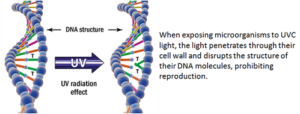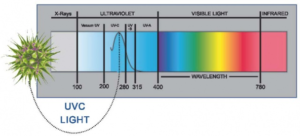Get answers to some of the most-asked questions
Lately, we’ve been getting numerous questions from our customers about the use of ultraviolet (UV) light and whether it acts as a sterilization or disinfection technique that’s worth pursuing. Here’s some information that should clarify how UV is used—and when it’s not appropriate.
What is Ultraviolet?
Ultraviolet (UV) light is one form of electromagnetic energy produced naturally by the sun. UV is a spectrum of light just below the visible light and it is split into four distinct spectral areas – Vacuum UV or UVV (100 to 200 nm), UVC (200-280 nm), UVB (280 to 315 nm) and UVA (315 to 400 nm).
What is Ultraviolet C?
The entire UV spectrum can kill or inactivate many microorganism species, preventing them from replicating. UVC energy at 253.7 nanometers provides the most germicidal effect. The application of UVC energy to inactivate microorganisms is also known as Germicidal Irradiation or UVGI.

UVC exposure inactivates microbial organisms such as bacteria and viruses by altering the structure and the molecular bonds of their DNA (Deoxyribonucleic acid). DNA is a “blue print” these organisms use to develop, function and reproduce. By destroying the organism’s ability to reproduce, it becomes harmless since it cannot colonize. After UVC exposure, the organism dies off leaving no offspring, and the population of the microorganism diminishes rapidly.
Ultraviolet germicidal lamps provide a much more powerful and concentrated effect of ultraviolet energy than can be found naturally. Germicidal UV provides a highly effective method of destroying microorganisms.
Does UV light sterilize everything in an area?
First, a note on definition. Disinfection and sterilization are both a type of decontamination process, but differ in terms of method and result. Disinfection reduces harmful microorganisms, while sterilization kills all microorganisms. This is an important distinction, because unless we’re in a scientifically controlled environment, we’re not able to sterilize, only disinfect. That said, reducing harmful microorganisms is crucial, and UV light is an effective component in an overall disinfection strategy.
How is UV used in disinfection of a building?
Most likely, you’ve seen images or video of UV disinfection on the news since it’s being used right now in places like airline cabins and subway cars. Those systems are different than what’s used in HVAC air-handling equipment and water filtration, mainly because there are major differences in applications.
Ultraviolet light for germicidal disinfection (UVGD) has one major limit. UV only works in its light path and can be blocked by objects creating shadows. Inline water filters and air handlers work well because we move the particle being disinfected directly across the light path for a specific amount of contact time. That light needs to be in the UV-C wavelength to be effective — blacklights, on the other hand, have a UV-A wavelength and are not effective because the energy won’t be strong enough to penetrate the lipid skin of a cell.
This issue can be minimized by using multiple UV bulbs to generate UV irradiation from different angles, but that would take a lot of time in one small space. Another solution is to use larger robotic disinfection systems. These systems are being used in hospitals and medical research where the cost of the robot units is offset by the potential lost revenue of hospital acquired infections (HAI) if they weren’t used. These robots may be less practical elsewhere, but that doesn’t mean some degree of UV disinfection won’t be helpful.
What about the handheld UV wands now in the consumer market?
These are nice tools, but effectiveness and practicality limitations do exist. First, the light must be hand-waved for a specific length of time over the surface and through the air of the inanimate object being disinfected. This is time consuming, and subject to a lot of human error, whereas electrostatic chemical disinfection can often be completed in a fraction of the time with the same efficacy and cost.
Second, these bulbs often contain high amounts of mercury and can present safety and disposal hazards. Finally, it’s not clear whether these wands on the market are calibrated to the right wavelength all the time. Some may be just blacklights, which do nothing to damage DNA, so that means it wouldn’t be strong enough to penetrate the nucleocapsid of a virus or envelope of other pathogens. Consumers need to do their research when purchasing these tools.
What’s the benefit of installing UV-C lighting in water and air systems?
This is the single point where we control a free-floating molecule and it is for this reason, it may be the most practical application for non-healthcare facilities. Air and water are fluids, we can push or pull those fluids in a very controlled way past a contact surface and use that surface to apply the light.
These systems must be engineered with the proper fixtures, placement, safety, and lamp type based on criteria such as the volume, velocity, humidity of the space, design temperatures, use of space, control surfaces, and a host of other considerations. The benefit is that while air is moved across the filter media, ongoing disinfection occurs.
As buildings become more efficient—in ongoing efforts to save cost and reduce the carbon footprint—newer systems are designed to reuse and recirculate more of that air repeatedly through economizers and return air mixing boxes. This makes inline filtration and disinfection a more important component in the overall effectiveness of a healthy facilities management strategy to reduce harmful pathogens and one that UG2 considers with customers when discussing Engineering4Health as part of our UG2 ReNewSM strategy.
What else should be in place for an efficient disinfection system?
Light from any UV-C filtration in an air handler or water system cannot reach the hard surface in the room. For this reason, this type of system should only be employed alongside other engineering controls and human behaviors as components in a holistic facilities management strategy.
These include an effective janitorial program, a properly trained staff using the correct personal protective equipment, correct social distancing, and well-maintained room pressure and/or isolation based on room occupancy and potential infection levels. And of course, proper hand hygiene.
